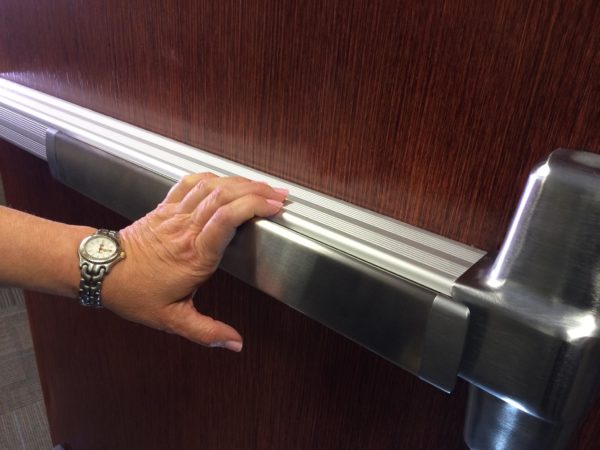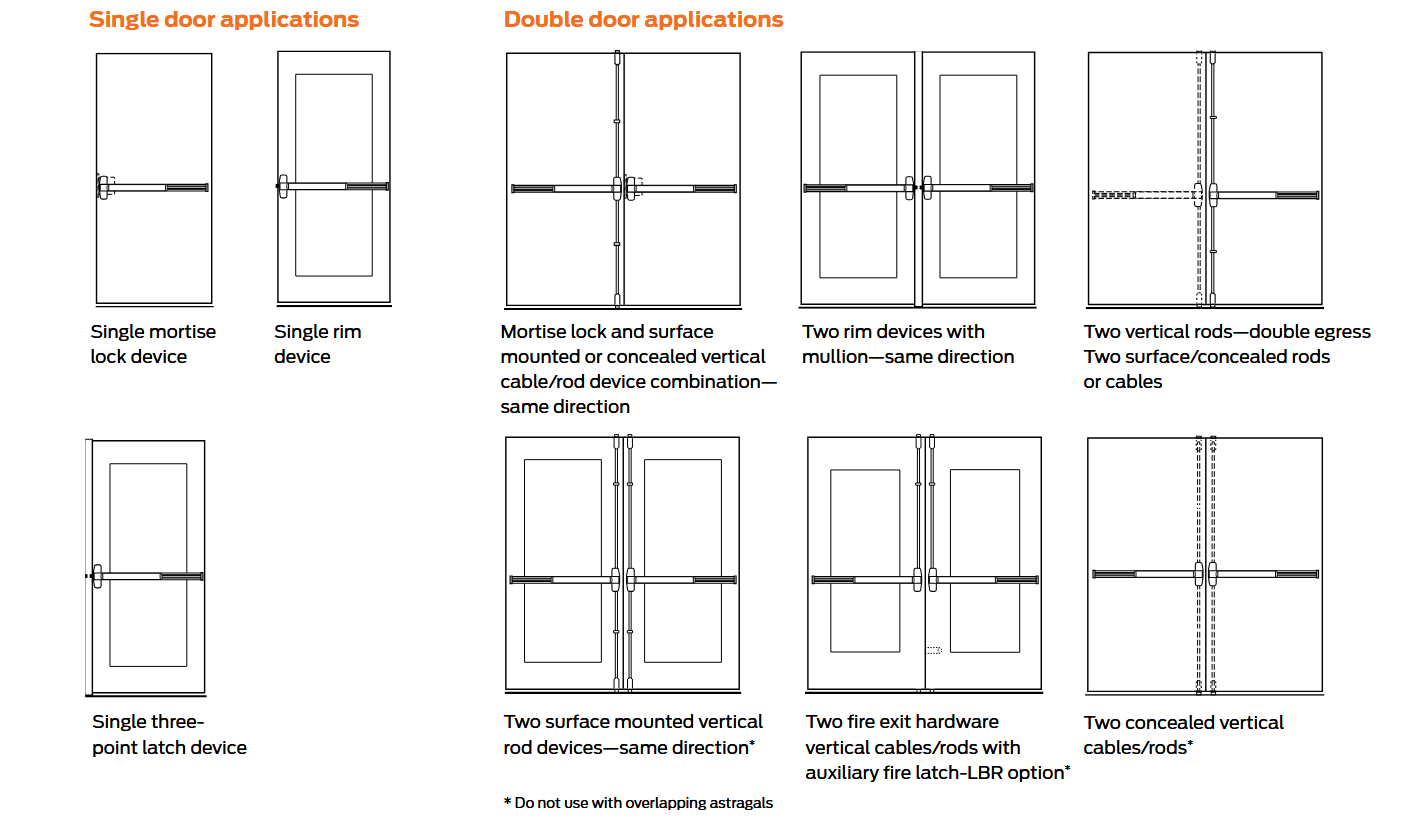 Panic hardware, also known as an exit device (or fire exit hardware when used on fire doors), is designed to provide fast and easy egress to allow building occupants to exit safely in an emergency. Code publications define panic hardware as, “a door-latching assembly incorporating a device that releases the latch upon the application of a force in the direction of egress travel.” Panic hardware may also be used because of durability, security, or ease of use, even when it is not required by code.
Panic hardware, also known as an exit device (or fire exit hardware when used on fire doors), is designed to provide fast and easy egress to allow building occupants to exit safely in an emergency. Code publications define panic hardware as, “a door-latching assembly incorporating a device that releases the latch upon the application of a force in the direction of egress travel.” Panic hardware may also be used because of durability, security, or ease of use, even when it is not required by code.
Code Requirements
The Life Safety Code (NFPA 101) and the International Building Code (IBC) both include requirements pertaining to panic hardware. Local codes may be different, so be aware of any special requirements for your project’s jurisdiction. The IBC and NFPA requirements vary depending on which publication and edition are being enforced:
- IBC 2006 edition and subsequent editions – Each door in a means of egress equipped with a lock or latch, serving:
- Assembly or Educational Occupancies with a calculated occupant load of 50 people or more.
- High Hazard occupancies (any occupant load).
- IBC 2003 edition – Each door in a means of egress equipped with a lock or latch, serving:
- Assembly or Educational Occupancies with a calculated occupant load of 100 people or more.
- High Hazard (H-1, H-2, H-3, or H-5) Occupancies (any occupant load).
- NFPA 101 – Required means of egress doors equipped with a lock or latch, serving:
- Assembly, Educational, or Day Care Occupancies with a calculated occupant load of 100 people or more.
- Areas of high hazard contents with a calculated occupant load in excess of 5.
[Note that there is an exception for the main entrance door or doors to a building or tenant space, under certain conditions. You can read more about using key-operated locks in lieu of panic hardware in this Decoded article.]
The National Electric Code (NFPA 70) includes requirements for panic hardware on doors serving rooms housing electrical equipment of certain voltage or amperage, when the door is within 25 feet of the required working space. The IBC also requires panic hardware on some electrical rooms as well as some refrigeration machinery rooms.
If a door is not equipped with a latch or lock (push/pull application), the door is not required to have panic hardware. Keep in mind that when an application requires panic hardware, all of the doors in the means of egress from that room or area will typically require panic hardware, including the exit access, the exit, and the exit discharge. The exception to this rule is the code requirement for panic hardware on electrical rooms and refrigeration machinery rooms.
Other Code Considerations
- Panic hardware must be listed to UL 305 – Standard for Panic Hardware. NFPA 101 also requires panic hardware to comply with ANSI/BHMA A156.3 – Standard for Exit Devices.
- Where panic hardware is required, the actuating portion of the device (touchpad or crossbar) must measure at least half the width of the door leaf.
- Current codes require panic hardware to be mounted between 34 inches and 48 inches above the floor. Existing panic hardware may have been installed in accordance with previous code requirements. Some state and local codes include a more restrictive mounting height range.
- According to the model codes, a force of 15 pounds applied to the touch-pad or cross-bar must release the latch. The ADA Standards for Accessible Design have been modified to require door hardware to operate with 5 pounds of force, which has created a conflict between the code requirements.
- No additional locking device (deadlock, chain, padlock & hasp, etc.) may be installed on a door required to have a panic device, and panic hardware may not be equipped with any device that prevents the release of the latch when the touch-pad or cross-bar is pressed. The exception to this is a delayed egress device.
- When panic hardware is used on fire doors, it must be fire exit hardware and the door must be equipped with a label stating “Fire Door to be Equipped with Fire Exit Hardware.” Fire exit hardware is labeled as such, and is not equipped with a mechanical “dogging” mechanism. An electric latch retraction device may be used to provide dogging for fire exit hardware, as long as the latch projects automatically upon actuation of the smoke detection system.
- If panic hardware is used on balanced doors (doors where the pivot point is located several inches in from the hinge edge of the door) a pushpad/touchpad device must be used and the actuating portion of the device must not extend more than half the width of the door. Crossbar style devices may not be used on balanced doors. The reason for this is that if the actuating portion extended all the way over to the hinge edge of the door, a building occupant could push on the wrong end of the panic device and the door would not open.
- In some jurisdictions, doors and hardware must meet testing requirements for hurricane and tornado protection. Consult the applicable codes and manufacturers’ certifications for compliance information.
Selection Criteria
Style: There are three basic types of panic hardware, dependent on aesthetic requirements, door design, and sometimes other factors.
- The touchpad style is the most common type used currently, and allows flexibility when electrified options are required – electrified lever trim, electric latch retraction, or delayed egress.
- The crossbar style is often used when aesthetics dictate a minimal silhouette for glass doors, or a vintage look, but the electrified options are limited because of the lack of space in the device to house electronic components. The width of a door’s vertical stiles must be considered when specifying or supplying touchpad or crossbar style panic hardware.
- Recessed panic hardware reduces the projection of the hardware from the face of the door, but requires a cut-out in the door and may limit the door material to hollow metal.
Type: Various types of panic hardware are available, based on whether it is used on a single or pair of doors, and functional requirements:
- Rim – A rim panic device is surface-mounted on the door, with the latch projecting from the panic device rather than the door edge. This is the simplest configuration of panic hardware, and the easiest to maintain. Rim panics can be used on single doors, or on pairs of doors in conjunction with a removable mullion. The rim x rim x removable mullion is a very secure application for pairs of doors, because the alignment of the doors is less critical than with vertical rod devices. A key-removable mullion makes the mullion easy for authorized users to remove.
- Mortise – A mortise panic device has a mortise lock body which is installed in the door, with the panic hardware mounted on the door face but controlling the mortise lock. Mortise panics are less commonly used than rim panics, likely because of the more complex door preparation and product design. For fire rated pairs with a 3-hour label, mortise fire exit hardware is sometimes used in conjunction with vertical rod fire exit hardware on the other leaf, but some manufacturers have successfully tested their products for 3 hours with vertical rod fire exit hardware on both leaves.
- Vertical Rod / Cable – These would typically be used for pairs of doors, and the rods and latches may be surface-mounted on the face of the door, or concealed inside of the door. For concealed applications, there is also a device available which incorporates cables instead of rods, for easier installation and maintenance. Vertical rod fire exit hardware is sometimes installed “less bottom rod” (LBR) or “less bottom bolt (LBB), which allows floor strikes to be omitted along with the bottom rods and latches. An auxiliary pin is typically required to ensure alignment during a fire.
- Multi-Point – A multi-point device combines vertical rods and a rim device, for 3-point latching. These may be used for security purposes, or to meet windstorm requirements.
Trims and Controls – The outside trim or control is used to retract the panic hardware latch(es) from the exterior. The exit-only function has no exterior trim. Nightlatch function is typically used where panic hardware is “dogged” to unlock the door, and may have a cylinder only, a cylinder and a pull handle, or a cylinder with a fixed lever handle. In some cases, a thumbpiece may be used in addition to the cylinder, to provide additional leverage to retract the latches. Lever trim is available in passage, storeroom, or classroom functions, as well as electrified functions. Knobs and thumbpiece trims are also available, although they are less commonly used because of current accessibility requirements.
Finishes – Panic hardware is available in a variety of finishes, including architectural plated finishes, stainless steel (when the base material is stainless steel), and powder coat finishes – both standard and custom colors.
Dogging – The act of dogging a panic device holds the latch(es) retracted to allow the door to operate as a push-pull function. This saves wear and tear on the hardware, and makes it easier for building occupants to use. Dogging may be done via hex-key, key cylinder, or thumbturn, and must be specified with the preferred option. The mechanical dogging function is not available for fire doors because the doors must have an active latch bolt for positive latching, but electric latch retraction may be used to provide the same function. Refer to this post for more information about dogging.
Electrified Functions – Panic hardware can be supplied with electric latch retraction, electrified lever trim, delayed egress, alarms, switches, or other electrified options to meet the access control and monitoring needs of the facility.
Conclusion
For questions about panic hardware options, assistance with special applications, or a complete specification, Allegion has more than 100 specification writers and architectural consultants available to help. We are also an AIA/CES approved provider, and conduct a wide range of courses offering AIA continuing education units. For help with code-compliance and product application, explore idighardware.com, where you can ask a specific question of your local ACE (Allegion Code Expert) using the Help button.
For additional information, refer to our whiteboard animation videos on panic hardware:




